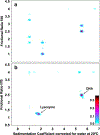A two-dimensional spectrum analysis for sedimentation velocity experiments of mixtures with heterogeneity in molecular weight and shape
- PMID: 19247646
- PMCID: PMC12146834
- DOI: 10.1007/s00249-009-0413-5
A two-dimensional spectrum analysis for sedimentation velocity experiments of mixtures with heterogeneity in molecular weight and shape
Abstract
We report a model-independent analysis approach for fitting sedimentation velocity data which permits simultaneous determination of shape and molecular weight distributions for mono- and polydisperse solutions of macromolecules. Our approach allows for heterogeneity in the frictional domain, providing a more faithful description of the experimental data for cases where frictional ratios are not identical for all components. Because of increased accuracy in the frictional properties of each component, our method also provides more reliable molecular weight distributions in the general case. The method is based on a fine grained two-dimensional grid search over s and f/f (0), where the grid is a linear combination of whole boundary models represented by finite element solutions of the Lamm equation with sedimentation and diffusion parameters corresponding to the grid points. A Monte Carlo approach is used to characterize confidence limits for the determined solutes. Computational algorithms addressing the very large memory needs for a fine grained search are discussed. The method is suitable for globally fitting multi-speed experiments, and constraints based on prior knowledge about the experimental system can be imposed. Time- and radially invariant noise can be eliminated. Serial and parallel implementations of the method are presented. We demonstrate with simulated and experimental data of known composition that our method provides superior accuracy and lower variance fits to experimental data compared to other methods in use today, and show that it can be used to identify modes of aggregation and slow polymerization.
Figures




References
-
- Brookes EH, Demeler B (2006) Genetic algorithm optimization for obtaining accurate molecular weight distributions from sedimentation velocity experiments. In: Wandrey C, Cölfen H (eds) Analytical ultracentrifugation VIII, Springer Progr Colloid Polym Sci 131:78–82
-
- Brookes EH, Demeler B (2007) Parsimonious regularization using genetic algorithms applied to the analysis of analytical ultracentrifugation experiments. GECCO proceedings ACM 978–1-59593–697-4/07/0007
-
- Brookes EH, Boppana RV, Demeler B (2006) Computing large sparse multivariate optimization problems with an application in biophysics. Supercomputing ‘06 ACM 0–7695-2700–0/06
Publication types
MeSH terms
Substances
Grants and funding
LinkOut - more resources
Full Text Sources
Other Literature Sources

